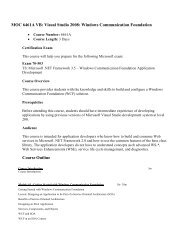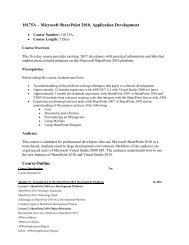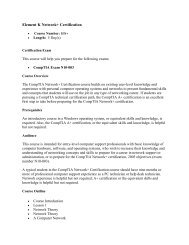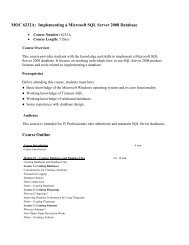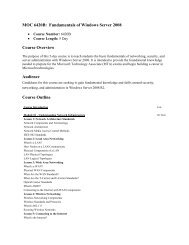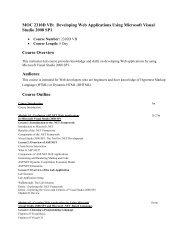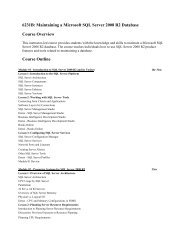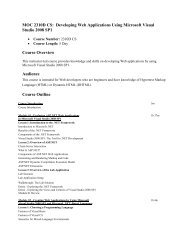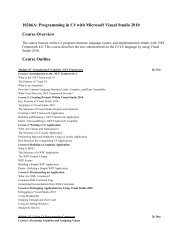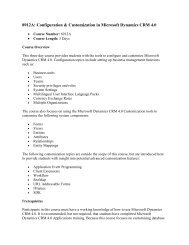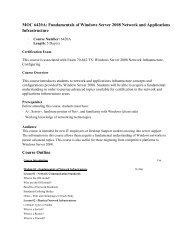CompTIA A+ Essentials Edition - New Horizons Ireland e-Learning ...
CompTIA A+ Essentials Edition - New Horizons Ireland e-Learning ...
CompTIA A+ Essentials Edition - New Horizons Ireland e-Learning ...
Create successful ePaper yourself
Turn your PDF publications into a flip-book with our unique Google optimized e-Paper software.
<strong>CompTIA</strong> <strong>A+</strong> <strong>Essentials</strong> <strong>Edition</strong><br />
Course Number: 220-701<br />
Length: 5 Day(s)<br />
Certification Exam<br />
This course is preparation for the <strong>CompTIA</strong> <strong>A+</strong> <strong>Essentials</strong> Certification exam<br />
Course Overview<br />
<strong>CompTIA</strong> <strong>A+</strong> <strong>Essentials</strong> measures the necessary competencies of an entry-level IT professional with at<br />
least 500 hours of hands-on experience in the lab or field. It tests for the fundamentals of computer<br />
technology, networking and security, as well as the communication skills and professionalism now<br />
required of all entry-level IT professionals.<br />
Prerequisites/Audience<br />
This course is appropriate for entry-level service technicians.<br />
Course Outline<br />
Course Introduction 4m<br />
Course Introduction<br />
Module 01 - Troubleshooting Methodology 1h 4m<br />
Troubleshooting Methodology<br />
Popular Troubleshooting Models<br />
Basic Troubleshooting Stages<br />
<strong>CompTIA</strong>’s <strong>A+</strong> Model<br />
<strong>CompTIA</strong>’s Network+ Model<br />
Novell’s Model<br />
The ASID Model<br />
Gathering Information from the User<br />
Some Examples<br />
Identifying Hardware or Software Problem<br />
Information Resources<br />
Microsoft Help and Support<br />
Microsoft KB Article<br />
Demo - Help and Support in XP<br />
Demo - Help and Support in Vista<br />
Problem and Resolution Tracking<br />
Help Desk Software<br />
Professional Service<br />
Professional Communication Guidelines<br />
Pitfalls of Communication
Effective Communication<br />
Verbal Communication<br />
Verbal Guidelines<br />
Nonverbal Communication<br />
Customer Satisfaction<br />
Service-level Agreement<br />
Module 01 Review<br />
Module 02 - Operating Systems 3h 19m<br />
Operating Systems<br />
Windows<br />
Windows 7 Professional <strong>Edition</strong><br />
Macintosh (Mac) OS<br />
Mac OS X Leopard<br />
Linux<br />
Ubuntu Linux<br />
Windows Client Operating Systems<br />
Product Lifecycle<br />
Identify Available Support<br />
Not Available in Windows 7 Home Basic<br />
Not Available in Either Win 7 Home <strong>Edition</strong><br />
Available Only in Win 7 Enterprise & Ultimate<br />
Not Available in Vista Home Basic<br />
Not Available in Either Home Version<br />
Available in Home Premium & Ultimate<br />
Available Only in Windows Vista Ultimate<br />
Available in Ultimate and Enterprise<br />
Windows XP Professional Features<br />
Demo - Windows XP Professional<br />
Windows 2000 Features<br />
Windows 2000 Mobile Support<br />
Demo - Windows 2000 Professional<br />
32-bit versus 64-bit<br />
The Windows 7 Desktop<br />
The Windows Vista Desktop<br />
Windows XP Professional Desktop<br />
Windows 2000 Professional Desktop<br />
Windows Aero Features<br />
Windows Aero<br />
3D Windows Flip<br />
Windows 7 Aero Features<br />
Aero System Requirements<br />
Windows Explorer in Win 7 Professional<br />
Windows Explorer in Vista<br />
Windows Explorer in XP
Demo - Locating Windows 7 Interface Components<br />
The Control Panel (Vista)<br />
Control Panel Search<br />
Computer Management Console<br />
Network Folder<br />
Command-line Utility<br />
Task Manager<br />
Microsoft Management Console<br />
Demo - Vista Features<br />
Directory Structure<br />
Navigating Directories<br />
Libraries<br />
Creating Directories<br />
Creating Libraries<br />
Adding Folders to a Library<br />
A Library’s Included Locations<br />
Copying Directories<br />
Removing Directories<br />
Deleting Libraries<br />
Removing Folders from a Library<br />
Demo - Directories<br />
Binary and Text Files<br />
ASCII<br />
File-name Extensions<br />
Common File Extensions<br />
File Names and Extensions<br />
Batch Files<br />
Demo - Batch Files<br />
File Attributes<br />
Command-line Utility<br />
Attrib.exe<br />
Demo - File Attributes<br />
Demo - Command-line<br />
Sharing Files with Local Users<br />
Public Folder Sharing in Vista<br />
Windows 7 Personal Folders<br />
Shared Documents<br />
Demo - Sharing Files in the Public Folder with Local Users<br />
HomeGroups in Windows 7<br />
Demo - Exploring Homegroups
Permissions<br />
NTFS<br />
NTFS File Permissions<br />
NTFS Folder Permissions<br />
Guidelines for NTFS Permissions<br />
Assigning NTFS Permissions<br />
Demo - Setting NTFS Permissions<br />
Module 02 Review<br />
Module 03 - Electricity and Power Supplies 58m<br />
Electricity and Power Supplies<br />
Characteristics of Electricity<br />
Alternating and Direct Current<br />
Characteristics, continued<br />
Electricity<br />
Safety Precautions<br />
Electrostatic Discharge (ESD)<br />
Preventing Static Buildup<br />
Preventing Static Discharge<br />
An Antistatic (ESD) Wrist Strap<br />
Typical Internal Components<br />
Slide Catches<br />
Determining Which Side to Open<br />
Removable Front Cover<br />
Live Demo - ESD<br />
Live Demo - Outside of the Computer<br />
Live Demo - Inside of the Computer<br />
A PC Power Supply<br />
Voltage Selection Switch<br />
Live Demo - Modern Power Supply<br />
Live Demo - Legacy Power Supply<br />
Power Supply Specifications<br />
Typical Power Requirements<br />
Standard Outputs<br />
Power Connectors<br />
Peripheral Power Connector<br />
Live Demo - Peripheral Power Connector<br />
Floppy Power Connector<br />
SATA Power Connector<br />
Wire Colors<br />
Live Demo - Wire Colors<br />
Motherboard Power Connectors<br />
Live Demo - Motherboard Power Connectors<br />
Power Supply Form Factors<br />
Module 03 Review
Module 04 - CPUs and Motherboards 50m<br />
CPUs and Motherboards<br />
Central Processing Unit (CPU)<br />
Control Units<br />
Execution Units<br />
CPU Performance<br />
CPU Design Characteristics<br />
Multiple-processor Support<br />
Processor Specifications<br />
Bus Width Specifications<br />
Internal Specifications<br />
Live Demo - Processor Installation<br />
Inside the Case<br />
Chipsets<br />
Northbridge and Southbridge<br />
CPU Packaging<br />
PGA (Pin Grid Array) Package<br />
SECC (Single Edge Cartridge ) Package<br />
Packages<br />
Common Desktop Sockets and Slots<br />
Pentium with MMX CPU & Socket 7 Socket<br />
Typical Cooling Mechanisms<br />
Cooling Notes<br />
Heat Sinks and Cooling Fins<br />
Power Supply and CPU Fans<br />
Cooling Fins<br />
Cooling Fins and a Fan<br />
Live Demo - Cooling Fins and a Fan<br />
Live Demo - Processor Fan<br />
Other Cooling Techniques<br />
Live Demo - Cooling Method<br />
Motherboards<br />
Components<br />
A Motherboard<br />
Live Demo - Motherboard<br />
Daughter Board<br />
Riser Card<br />
Live Demo - Riser Card<br />
Form Factor
Module 04 Review<br />
Module 05 - The Basic Input/Output System 46m<br />
The Basic Input/Output System<br />
Firmware<br />
BIOS<br />
CMOS<br />
CMOS Battery<br />
CMOS Configuration<br />
CMOS Utility Access Examples<br />
CMOS Configurable Settings<br />
BIOS Configuration Procedure<br />
Demo - BIOS<br />
BIOS Updates<br />
BIOS Update Sources<br />
Determining the BIOS Version<br />
Flashing the BIOS<br />
BIOS Update Failures<br />
Recovering from a Failed Update<br />
Bad CMOS Battery<br />
Replacing CMOS Battery<br />
Live Demo - Replacing CMOS Battery<br />
POST Process<br />
Beep Codes<br />
Numeric Codes<br />
Logo Screen<br />
The Boot Process<br />
Boot Devices<br />
Boot Devices In The System BIOS<br />
Module 05 Review<br />
Module 06 - Memory Systems 1h 10m<br />
Memory Systems<br />
Memory<br />
Measuring Memory<br />
Larger Memory Units<br />
Memory Types<br />
Volatile vs. Non-volatile Memory<br />
Dynamic vs. Static Memory<br />
Asynchronous vs. Synchronous<br />
Memory Access Types<br />
Access Time<br />
Speed Ratings<br />
Banking Requirements<br />
Packaging
Single- and Double-sided Modules<br />
Package Types: Desktops<br />
Package Types: Laptops<br />
Package Type: Printers<br />
Memory Error Recovery<br />
Parity<br />
Demo - Legacy Memory Modules<br />
Live Demo - Legacy Memory Modules<br />
Live Demo - Modern Memory Modules<br />
Live Demo - Notebook Memory<br />
Task Manager<br />
Performance Tab Indicators<br />
The Performance Tab<br />
Demo - Task Manager<br />
Virtual Memory<br />
Optimizing the Page File<br />
Demo - Page File<br />
Module 06 Review<br />
Module 07 - Bus Structures 49m<br />
Bus Structures<br />
Buses<br />
PCI Bus Slots<br />
Video Bus<br />
An AGP Video Bus Slot<br />
The Riser Bus<br />
Three Riser Standards:<br />
System Interaction<br />
Interrupts<br />
IRQs<br />
Device Manager: IRQs<br />
I/O Addresses<br />
Device Manager: I/O Addresses<br />
DMA Channels<br />
Device Manager: DMA Channels<br />
Base Memory Addresses<br />
Device Manager: Base Memory<br />
Demo - Device Manager<br />
Bus Types<br />
PC/XT Bus<br />
PC/XT Card<br />
PC/AT and ISA Bus<br />
ISA Adapter<br />
Live Demo - Comparing ISA to PCI<br />
ISA Expansion Bus Slot
PCI Bus<br />
PCI Adapter<br />
Live Demo - Bus Slots<br />
PCI Slots<br />
PCIe<br />
Multifunction Cards<br />
Need for Video Buses<br />
VESA Local Bus<br />
VLB Adapter<br />
PCI-based Video<br />
AGP<br />
AGP Adapter<br />
AGP Standards<br />
AGP Characteristics<br />
AGP Slots<br />
An AGP Slot<br />
PCIe 02<br />
A PCIe Video Card<br />
Live Demo - Graphics Slots<br />
Module 07 Review<br />
Module 08 - Expansion Cards 1h 8m<br />
Expansion Cards<br />
Controllers and Interfaces<br />
PC Drive Interfaces<br />
IDE/ATA<br />
ATA Standards<br />
PIO Modes<br />
DMA Modes<br />
UltraDMA Modes<br />
ATA Motherboard Connectors<br />
Standard ATA Drive Cable<br />
High-speed 80-pin ATA Drive Cable<br />
SATA Data Cable<br />
Live Demo - SATA Cable<br />
Drive Capacities<br />
Drive Identification<br />
Primary and Secondary Channels<br />
Live Demo - Drive Identification<br />
SCSI<br />
SCSI Device IDs<br />
Termination<br />
SCSI ID and Termination<br />
Differential SCSI
ST506 / ST 412 Interface<br />
ESDI Interface<br />
USB Interfaces<br />
IEEE 1394 (FireWire, i.Link) Interfaces<br />
Video Adapters<br />
Creating an Image<br />
Maximum Colors<br />
Video Standards<br />
SuperVGA<br />
15-pin VGA/SVGA Connector<br />
VGA/SVGA Connector and Socket<br />
DVI Connection Types<br />
DVI-D Port<br />
DVI-I Port<br />
HDMI (High-Definition Multimedia Interface)<br />
Live Demo - Identifying Video Adapter Types<br />
PC Sound<br />
Sound Card Components<br />
A Sound Card<br />
Sound Card Connectors<br />
Live Demo - Sound Connectors<br />
Speakers<br />
CD Audio<br />
Modems<br />
Riser Cards - AMR<br />
Riser Cards - CNR<br />
Riser Cards - ACR<br />
Comparing AMR and CNR<br />
Softmodems<br />
When a Modem isn’t a Modem<br />
Modem Connections<br />
Live Demo - RJ-11 Connectors<br />
Live Demo - Network Cards and Cables<br />
Data Transmission Speed<br />
ITU Standards<br />
MNP Classes<br />
Error Detection and Compression<br />
Module 08 Review<br />
Module 09 - Peripheral Connection Types 1h 34m<br />
Peripheral Connection Types<br />
Ports<br />
Serial Ports<br />
Serial Port Characteristics<br />
Serial Port Characteristics – Parity Options
Serial Port Characteristics – Flow Control<br />
Male and Female Connectors<br />
Serial Cables<br />
Serial Connector Pin Numbering<br />
Pin Numbers<br />
9-pin Null Modem Connections<br />
25-pin Null Modem Connections<br />
Live Demo - Serial Connectors<br />
Parallel Ports<br />
Parallel Port Resources<br />
Port Types<br />
Printer Port Types<br />
Female 25-pin Parallel<br />
Centronics<br />
Live Demo - 25-pin Parallel Port/Centronics Connector<br />
Input Devices<br />
Keyboard Port and Connector<br />
AT Keyboard Port and Connector<br />
Mouse Port and Connector<br />
Bar Code Reader with Y-cable<br />
Live Demo - PS/2 Keyboard and Mouse<br />
Live Demo - USB Mouse<br />
Demo - USB Mouse<br />
Mouse Properties<br />
Demo - Mouse Properties<br />
Keyboard Properties<br />
Demo - Keyboard Properties<br />
KVM Switch<br />
PS/2 KVM<br />
USB KVM<br />
USB Features<br />
USB Classes<br />
USB Device Classes<br />
USB Versions<br />
USB Symbols<br />
USB Devices in Device Manager<br />
USB Ports<br />
USB Connectors<br />
Live Demo - USB Connectors<br />
USB Specifications<br />
USB Power<br />
Installing USB Device via USB Port<br />
Installing USB Devices<br />
FireWire Features<br />
FireWire Versions
Isochronous Transfers<br />
4-pin FireWire Port and Connector<br />
6-pin FireWire Ports and Connector<br />
FireWire Power<br />
Installing IEEE 1394 Devices<br />
Live Demo - FireWire Cable<br />
Multimedia Connections<br />
1/8" Connectors<br />
Example of Line-in Device<br />
Speakers Connected to a PC<br />
Speakers Connected Together<br />
Microphone Connection to a PC<br />
Live Demo - Back of PC<br />
RCA Connectors<br />
S-Video Connectors<br />
RCA and S-Video Connectors<br />
Coax Connectors<br />
Coax Connector<br />
MIDI Connectors<br />
S/PDIF<br />
S/PDIF Connections<br />
Module 09 Review<br />
Module 10 - Data Storage Devices 1h 43m<br />
Data Storage Devices<br />
Hard Drive Components<br />
Components of Magnetic Hard Drive<br />
Solid-state Drives<br />
Solid-state Drive Advantages<br />
Magnetic Drive Advantages<br />
Hard Drive Geometry<br />
Head Crash<br />
Hard Drive Connections<br />
Partitioning<br />
Partition Types<br />
Partitioning Utilities<br />
File Systems<br />
FAT File System<br />
NTFS File System<br />
FAT vs. NTFS<br />
Directory Trees<br />
Root directory of C:<br />
Formatting<br />
Demo - Disk Manager<br />
Fault Tolerance
RAID Levels<br />
Choosing a RAID Level<br />
Striped Volume<br />
Mirrored Volume<br />
RAID 5<br />
Software and Hardware RAID<br />
Hardware RAID Advantages<br />
Components of a CD<br />
Recordable CDs<br />
CD Drive Components<br />
CD Drive Speeds<br />
DVDs<br />
DVD Types<br />
DVD Standards<br />
Blu-Ray Discs<br />
Optical Drive Connections<br />
Live Demo - Optical Drive Connections<br />
Using a CD<br />
Using CD and DVD Drives<br />
Demo - Using an Optical Drive<br />
USB Flash Drives<br />
USB Technical Specifications<br />
Flash MP3 Player<br />
USB Drivers<br />
Demo - USB Drives<br />
Floppy Disks<br />
5.25" Floppy Disk<br />
3.5" Floppy Disk<br />
Floppy Disk Storage<br />
Capacities<br />
Write Protection<br />
Floppy Controller Resources<br />
Floppy Drive Cable<br />
Floppy Controller Connector<br />
Diskette Preparation<br />
Tape Drives<br />
Tape Formats<br />
Tape Head Cleaning<br />
Hard Disk Maintenance<br />
Disk Cleanup<br />
Demo - Disk Cleanup<br />
ScanDisk<br />
ScanDisk Versions<br />
Demo - Running Scan Disk
Chkdsk<br />
Disk Defragmenter<br />
Disk Defragmenter in Windows XP<br />
Demo - Defragmenting a Disk<br />
Module 10 Review<br />
Module 11 - Video Output and Image Input Devices 36m<br />
Video Output and Image Input Devices<br />
CRT Monitor<br />
CRT Components<br />
How CRTs Produce Images<br />
Degaussing<br />
CRT Characteristics<br />
Video Connectors<br />
Display Properties<br />
Display Adjustments<br />
Safety<br />
Flat-Panel Monitor<br />
LCD Advantages<br />
How an LCD Works<br />
Flat-Panel Monitor Characteristics<br />
Touch-Screen<br />
Touch-Screen Input<br />
Laptop Monitors<br />
Flat-Panel Monitor Connections<br />
TMDS<br />
LCD Monitor Installation<br />
Multiple Monitors<br />
Display Projectors<br />
DisplayPort Technology<br />
Demo - Multiple Monitors<br />
Scanners<br />
Flatbed Scanner<br />
Multifunction Sheet-feed Scanner<br />
Hand-held Scanner<br />
TWAIN<br />
Scanner Configuration Features<br />
Scanner Connections<br />
Digital Cameras<br />
Resolutions<br />
Digital Camera Memory Cards<br />
Memory Cards<br />
Printing Images<br />
Digital Camera Connections<br />
Memory Card Readers
Web Cameras (IP Camera’s)<br />
Webcam Example<br />
Network Cameras<br />
Network Camera Example<br />
Network Camera Uses<br />
Headsets, Microphones, and Speakers<br />
Connection Software<br />
Module 11 Review<br />
Module 12 – Printers 48m<br />
Printers<br />
Dot-Matrix Printer<br />
Dot-Matrix Printer Components<br />
Dot-Matrix Printer Connections<br />
Dot-Matrix Options<br />
Other Impact Printers<br />
An Inkjet Printer<br />
Inkjet Process<br />
Inkjet Cartridge Print Heads<br />
Print Heads<br />
Inkjet Print Quality<br />
Straight-Through Paper Path<br />
Curved Paper Path<br />
Photo Printers<br />
Printing onto a CD<br />
Laser Printer<br />
Laser Printer Components<br />
Toner Cartridge Components<br />
Laser Scanner Assembly<br />
Power Supplies<br />
Paper Control and Transport Assembly<br />
Transfer Corona Assembly<br />
Fusing Assembly<br />
Electronic Control Package<br />
Laser Printing Process<br />
Live Demo - Printers<br />
Other Printer Types<br />
Plotter<br />
Additional Printer Types<br />
Main Windows Print Processes<br />
Client Printer Process<br />
Spooler Process<br />
Inkjet Printer Installation<br />
Ink-Level Monitoring Utility<br />
Printer Interfaces
Inkjet Communications Interfaces<br />
Configure the Connection Type<br />
Parallel Port in Device Manager<br />
Installing an Inkjet Printer<br />
Upgrading a Device Driver<br />
Laser Printer Installation<br />
Laser Printer Interfaces<br />
Communications Interfaces<br />
Installing a Laser Printer<br />
Installing a Network Printer in Windows 7<br />
Printer Configuration Options<br />
Demo - Installing a Local Printer<br />
Printer Options<br />
Maintenance<br />
Dot-Matrix Printer Maintenance<br />
Inkjet Printer Maintenance<br />
Laser Printer Maintenance<br />
Module 12 Review<br />
Module 13 - Connecting Computers 1h 54m<br />
Connecting Computers<br />
Local Area Network<br />
Example of a LAN<br />
Basic Types of Networks<br />
The Peer-to-Peer Model<br />
A Peer-to-Peer Network<br />
Peer-to-Peer Authentication<br />
Local User Accounts<br />
Using a Shared Resource<br />
The Client/Server Model<br />
A Client/Server Network<br />
Network Client<br />
The Logon Process<br />
Network Wiring<br />
Fiber Optic Cable<br />
Fiber Optic Cable Networks<br />
Twisted-Pair Cable<br />
Composite Cable<br />
Coaxial Cable<br />
Duplex<br />
Ethernet<br />
Ethernet Media<br />
Ethernet Standards<br />
Wireless LAN<br />
Benefits & Drawbacks of WLANs
Wide Area Network<br />
WAN Connections<br />
POTS/PSTN<br />
ISDN<br />
VPN<br />
DSL<br />
Cable<br />
Satellite<br />
Wireless WAN<br />
Cellular<br />
3G Networks<br />
4G Networks<br />
T and E lines<br />
X.25 and Frame Relay<br />
ATM<br />
Fiber Optic Wired Connections<br />
SONET<br />
Fiber Optic Connectors<br />
Fiber Optic Connector Types<br />
Twisted-Pair Connections<br />
UTP Categories<br />
Stranded vs. Solid TP Cable<br />
Twisted-Pair Connectors<br />
RJ Connectors<br />
Modern Residential Wiring<br />
RJ-25 Pinout<br />
RJ-45 Connector<br />
Pin Numbering of RJ-45 Connector<br />
Live Demo - RJ-45 and RJ-11 Connectors<br />
Coaxial Connections<br />
Common Components of Coaxial<br />
RG Standards<br />
Thinnet Connectors<br />
Thicknet Vampire Tap<br />
Live Demo - Coax and Coax Networks<br />
Plenum Wiring<br />
Network Interface Card<br />
Computer Network Connections<br />
PCI Ethernet Card<br />
Notebook Computers<br />
NIC Selection<br />
Status Indicator Lights<br />
Device Manager<br />
Live Demo - Examining your NIC<br />
Modems
Modulation/Demodulation<br />
Connections<br />
Star Topology<br />
Ethernet Hubs<br />
How a Hub Works<br />
Router<br />
Routing between Network Segments<br />
Routers: Key Points<br />
Live Demo - Configure Router<br />
Demo - Router Setup<br />
Layer 2 Switches<br />
VLAN Trunking<br />
Module 13 Review<br />
Module 14 - Networking Computers 3h 2m<br />
Networking Computers<br />
Network Protocol<br />
Wireless Network Protocols<br />
Demo - Install Protocols<br />
Addressing<br />
MAC Address<br />
IPv4<br />
Classful IPv4 Addresses<br />
IP Classes<br />
Parts of an IP Address<br />
Subnet Masks<br />
Network IDs<br />
Special Addresses<br />
APIPA<br />
CIDR<br />
CIDR Address<br />
IPv6<br />
IPv6 Address Types<br />
IPv6 Address Scopes<br />
Default Gateway<br />
Routing Example<br />
Character-Based Names<br />
Domain Name System (DNS)<br />
Top-level Domains<br />
Countries As Top Level Domains<br />
<strong>New</strong> Top Level Domains<br />
NetBIOS<br />
Resolving NetBIOS by Broadcast<br />
Resolving NetBIOS by WINS
IPCONFIG<br />
Example of ipconfig /all Results<br />
Demo - ipconfig/all (xp)<br />
Demo - ipconfig /all (Windows 7)<br />
Ping<br />
Successful Ping<br />
Steps after Unsuccessful Ping<br />
Demo - Troubleshooting TCP/IP<br />
Demo - Ping<br />
TCP/IP Architecture<br />
Application-Layer Protocols<br />
HTTP<br />
FTP<br />
Telnet<br />
E-mail Protocols<br />
Port Addresses<br />
Service Port Addresses<br />
Demo - Netstat<br />
Static TCP/IP Configuration<br />
Demo - Configuring TCP/IP<br />
DHCP and DHCPv6<br />
The IPv4 Lease Process<br />
The IPv6 Lease Process<br />
IPv6 Router Flags<br />
Wireless Nodes on a Network<br />
Wireless Connection Components<br />
Wireless NICs<br />
Wireless Access Points<br />
Wireless Speeds<br />
WAP Configuration<br />
Securing your AP<br />
Wireless Authentication Methods<br />
The 802.1 Protocol<br />
Demo - Wireless Access Point<br />
Wireless Auto Configuration<br />
Wireless Network Problems<br />
Demo - Wireless Client<br />
Creating a Dial-up Connection<br />
Vista Dial-up Connection Wizard<br />
Vista: Connect to a Workplace<br />
Dial-up Connection Properties<br />
Module 14 Review<br />
Module 15 - Portable Computers 1h 22m<br />
Portable Computers
Notebook Computer<br />
Typical Notebook Components<br />
Live Demo - Mini PC Card<br />
Notebooks<br />
Netbooks<br />
Notebook Batteries<br />
Battery Types<br />
Power Adapters<br />
Power Indicator Lights<br />
Notebook Processors<br />
Notebook Memory<br />
Notebook Drives<br />
Accessing the Hard Drive<br />
Swapping a Removable Drive<br />
Live Demo - Hot-Swappable Components<br />
Notebook Keyboard<br />
LCD Monitors<br />
Native Resolutions<br />
Notebook Pointing Devices<br />
Touchpad<br />
Handwriting Technology<br />
Notebook Peripheral Ports<br />
Live Demo - Inside of Laptop<br />
Wireless Communication<br />
Infrared<br />
IrDA Port<br />
Radio<br />
802.11g Wireless Router<br />
Bluetooth<br />
Network Connections<br />
PC Card Types<br />
Type II PC Card<br />
Live Demo - Type II PC Card<br />
PC Card Bus Types<br />
Inserting and Removing PC Cards<br />
Card and Socket Services<br />
Mini PCI Card<br />
Live Demo - Mini PC Card 02<br />
Network Adapters and Modems<br />
Desktop Features<br />
Port Replicator<br />
Notebook Computer Issues<br />
Power Issues<br />
Demo - Power Management Utility<br />
Power-Related Measurements
Replacing the Battery<br />
Troubleshooting Power Problems<br />
Maintenance<br />
Operating Environment<br />
Transporting a Notebook<br />
Module 15 Review<br />
Module 16 - Monitoring and Management 1h 58m<br />
Monitoring and Management<br />
Windows Diagnostics<br />
System Information Window<br />
Remote Computer Information<br />
Demo - Windows Diagnostics<br />
Command-Line System Information<br />
DirectX Diagnostic<br />
DirectX Diagnostic Tool<br />
DirectX Diagnostic Pages<br />
Demo - DirectX Diagnostics<br />
Task Manager<br />
Windows Task Manager<br />
The Applications Tab<br />
Demo - Monitoring Applications<br />
The Processes Tab<br />
The Services Tab<br />
The Performance Tab<br />
Demo - Monitoring Performance<br />
The Networking Tab<br />
The Users Tab<br />
Computer Management<br />
Event Viewer<br />
Event Information<br />
Event Types<br />
Event Properties<br />
Demo - Event Logs<br />
Resource Overview<br />
Detailed View of CPU Resource<br />
Demo - Resource Monitor<br />
Performance Monitor<br />
Performance Monitor Real-Time Graph<br />
Performance Objects<br />
Bottlenecks<br />
Adding Counters<br />
Real-Time Monitoring<br />
Performance Monitor Configuration<br />
Performance Monitor Tabs
The Registry<br />
Registry Keys<br />
Registry Editors<br />
Windows Vista Registry Editor<br />
Registry Searches<br />
Registry Corruption and Backups<br />
Demo - Registry<br />
Demo - Registry Backup<br />
Services and Applications<br />
Services<br />
The Services Console<br />
Service Properties<br />
Dependencies<br />
Demo - Services<br />
Power Management<br />
Power Option Configuration<br />
Power Plans<br />
Demo - Power<br />
Sleep and Hibernation Modes<br />
Power Options: Notebooks<br />
Power Options: Desktops<br />
Wake Up on LAN<br />
A NIC’S “Wake Up on LAN” Settings<br />
Module 16 Review<br />
Module 17 - Operating System Troubleshooting 1h 13m<br />
Operating System Troubleshooting<br />
Startup Files<br />
Startup Process<br />
Startup Messages<br />
Operating-System Load Errors<br />
Windows Shutdown Error<br />
Demo - Startup Messages<br />
Advanced Startup Options<br />
Advanced Boot Options Menu<br />
Demo - Startup Modes<br />
System Configuration Utility<br />
Services Page<br />
Startup Modes for Troubleshooting<br />
Demo - System Configuration<br />
Recovery Console<br />
Folder Access in Recovery Console<br />
System Recovery Options Menu<br />
System Recovery Options<br />
Emergency Repair Disk
Windows 2000 Professional ERD<br />
Automated System Recovery<br />
ASR Tasks<br />
System Restore<br />
Vista System Protection<br />
Restoring the System<br />
System Restore in Vista<br />
Restore Points in Vista<br />
System Restore in Windows XP<br />
Restore Points in XP<br />
Demo - Creating a Restore Point<br />
Demo - Restoring a Computer to a Previous State<br />
Module 17 Review<br />
Module 18 – Security 1h 43m<br />
Security<br />
User Accounts<br />
User Names and Passwords<br />
Password Protection<br />
Creating Strong Passwords<br />
Multiple Passwords<br />
User Account Types<br />
Groups<br />
Demo - Local Users and Groups (XP)<br />
Demo - Vista Local User<br />
Demo - Active Directory Groups<br />
Authentication<br />
Authentication Protocols<br />
Security Policies<br />
Password Policies<br />
Setting Values<br />
Account Lockout Policy<br />
Computer vs. Domain<br />
Demo - Local Security Policies<br />
Encryption<br />
Encrypted File System<br />
Demo - Encryption<br />
Whole-Disk Encryption<br />
BitLocker Hardware Requirements<br />
BitLocker Authentication Modes<br />
BitLocker Life Cycle<br />
BitLocker Recovery<br />
Other Whole-Disk Encryption Systems<br />
Biometrics<br />
Biometric Devices
Pros and Cons of Biometric Devices<br />
Smart Cards<br />
Smart Card Components<br />
Smart Card Use<br />
Fobs<br />
BIOS Security<br />
Alleviating Security Risks<br />
Physical Access Restrictions<br />
Firewalls<br />
Firewall Functions<br />
Hardware Firewall<br />
Software Firewall<br />
Proxy Server<br />
Port and Packet Filters<br />
Windows Security Center<br />
Action Center in Windows 7<br />
Win7 Action Center Indicating a Problem<br />
Windows Firewall<br />
Windows Firewall Advanced Settings<br />
Demo - Configuring Windows Firewall<br />
Social Engineering Attacks<br />
Malicious Software<br />
Protecting Computer Systems<br />
Data Security and Destruction<br />
Data Destruction<br />
Data Migration<br />
Security Policy Contents<br />
Locking Windows Vista<br />
Security Classifications<br />
Module 18 Review<br />
Module 19 - Windows Installation and Upgrades 1h 19m<br />
Windows Installation and Upgrades<br />
Installing Windows Operating Systems<br />
Clean Installation vs. Upgrade<br />
Pre-Installation Tasks<br />
File Backup and Transfer<br />
Windows 7, All Versions<br />
Windows Vista Home Basic<br />
Windows Vista Home Premium and Business / Ultimate / Enterprise<br />
Windows XP Professional / Home<br />
Windows 2000 Professional<br />
Windows Media Center<br />
Hardware Compatibility<br />
The Upgrade Advisor
Windows 7 Upgrade Advisor<br />
Running the Upgrade Advisor<br />
Windows XP Upgrade Advisor<br />
Demo - Running the Windows 7 Upgrade Advisor<br />
Partitions and Formatting<br />
Windows Vista Installation Methods<br />
Windows 2000 / XP Installation<br />
Network Installation<br />
Unattended Installations<br />
Clean Install of Windows Vista<br />
Product Keys and Activation<br />
Windows Update<br />
Windows Vista Network Locations<br />
Windows XP / 2000 Installation<br />
Setup Issues<br />
Demo - Windows 7 Install<br />
Post-Installation Tasks<br />
Devices and Drivers<br />
Demo - Device Drivers<br />
Driver Signing<br />
Windows 7 Upgrade Paths<br />
Unsupported Upgrades<br />
Upgrade Between Windows 7 Versions<br />
Windows Vista Upgrade Paths<br />
Upgrade Between Vista Versions<br />
Pre-Windows Vista Upgrades<br />
Pre-Upgrade Tasks<br />
Hardware and Software Compatibility<br />
Upgrade Process<br />
Upgrades within Windows 7<br />
Upgrades within Windows Vista<br />
Upgrade Issues<br />
Application Compatibility<br />
Vista Program Compatibility Wizard<br />
Windows 2000 Application Compatibility<br />
Microsoft Assessment and Planning Toolkit<br />
MAP Readiness Reports<br />
MAP Toolkit Migration Evaluations<br />
Volume License Customers<br />
Demo - Upgrading to Windows 7 Ultimate<br />
Demo - Using the Windows 7 Program Compatibility Wizard<br />
Module 19 Review<br />
Module 20 - Safety and Maintenance 30m<br />
Safety and Maintenance
Office Hazards: Floor Surfaces<br />
Office Hazards: Fire Safety<br />
Fire Extinguisher Classes<br />
Fire Extinguisher Types<br />
Office Hazards: Electrical Safety<br />
Office Hazards: Air Quality<br />
Computer Hazards<br />
Physical Hazards<br />
Laser Printer and Copier Toner<br />
Electrical Hazards<br />
Incident Reporting<br />
High-Voltage Interference: Outside<br />
High-Voltage Interference: Inside<br />
Electrostatic Discharge (ESD)<br />
Electromagnetic Induction (EMI)<br />
Minimizing High-Voltage Interference<br />
Shielding and Filtering<br />
Ventilation, Dust, and Moisture Control<br />
Printer/Scanner Maintenance<br />
Power Conditioning<br />
Cleaning Computer Equipment<br />
Live Demo - Maintenance<br />
Material Safety Data Sheets (MSDS)<br />
MSDS Hazard Ratings<br />
Personal Protection by Rating<br />
Ergonomic Workstations<br />
Laptop Safety<br />
Computer Equipment Disposal<br />
Module 20 Review<br />
Module 21 - Troubleshooting Hardware 42m<br />
Troubleshooting Hardware<br />
Backing Up Files and Folders<br />
Windows Vista Backup Utility<br />
Automatic Backups<br />
Windows XP Backup<br />
Restoring Data<br />
Restoring Files in Windows XP<br />
Demo - Vista Backup<br />
Hardware Related Symptoms
Power-Supply Problems<br />
The Power_Good Signal<br />
Troubleshooting Motherboards & CPUs<br />
Motherboard and CPU Problems<br />
Memory Problems<br />
Drive Controller Problems<br />
Video Adapter Problems<br />
Sound Card Problems<br />
Modem Problems<br />
NIC Indicator Lights<br />
Hard Drive Problems<br />
CD Drive Problems<br />
DVD Drive Problems<br />
Module 21 Review<br />
Course Closure<br />
Total Duration: 28h 30m



